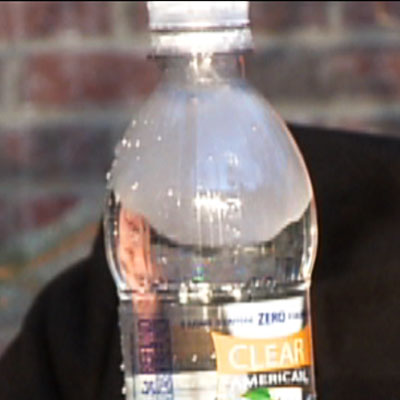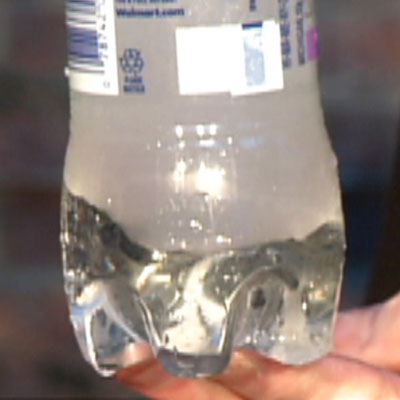Instant Freeze – Water Turns to Ice in a Flash
During the cold winter months, do you ever leave a bottle of water or soda in your car or garage overnight? What happens the next day when the drink is still liquid you twist off the cap and the drink instantly freezes! How does this work and what is the science behind it?
Grab some ice, some salt and some plastic bottles of soda water and try this very cool science demo.
This is a great illustration of how carbon dioxide can lower the freezing point of water.
Materials
- Seltzer water – flavored or plain in plastic bottles. Do not use glass bottles as the liquid may accidentally freeze in the bottle, causing it to explode.
- Large bucket
- Ice
- Rock salt
- Thermometer
Experiments
- THIS EXPERIMENT REQUIRES LOTS OF TRIAL AND ERROR. If it happens to work on the first attempt, count your lucky stars. Be patient and understand that all of the measurements of ice, water and rock salt are suggestions of what worked in our labs. Remember to video every attempt to be able to document your success. When the ice crystals begin to form, expect to hear lots of spontaneous screams and cheers.
- The demonstration works best if you place the unopened bottles of soda in the refrigerator for a few hours before attempting the activity.
- Start by filling the bucket or container 3/4 full with ice. Add enough water to make a slurry or a mixture where the ice can freely move around in the water.
- Add two cups of rock salt and stir.
- Place the cooled bottles of soda in the ice-salt mixture.
- Place the thermometer in the ice mixture – position the thermometer as close to one of the bottles as possible to get the most accurate reading of the bottle temperature.
- Watch the thermometer closely. The temperature of the soda needs to get down to about 17oF (that’s -8oC) for approximately 10 minutes. If the soda gets any colder, the liquid will freeze prematurely.
- Once the soda has been at the appropriate temperature for 10 minutes, gently remove the bottle from the ice-salt mixture and open the bottle. Ice crystals should immediately form at the top of the bottle and quickly make their way down through the bottle, creating an instant freeze.
- As a second experiment, remove another bottle from the ice bath and smack it down on a table without opening it. If the ice crystals begin to form, you have a very interesting piece of evidence to help better support your conclusion of how it works.
Again, NEVER use glass bottles for this demonstration as the soda may accidentally freeze, causing the bottle to explode. If you caught the freezing action on video, share it on our Facebook page at facebook.com/stevespangler
How does it work?
We offer two explanations for this phenomenon – be sure to read the second one!
Explanation #1
When soda is produced, large quantities of additives (like sugar and flavoring) and carbon dioxide bubbles are pumped into water to create bubbly, sugary soda pop. These additives are called solutes and when solutes are added to a liquid such as water, the freezing point of the water decreases. By lowering the freezing point, the soda has to reach a much colder temperature to freeze than water. However, the concentration of carbon dioxide in the soda is only maintained as long as the bottle is kept sealed. As soon as the soda is opened, and you hear that “whoosh” of fizz (carbon dioxide) rushing out of the bottle, the concentration of solutes in the water goes down, and the freezing point goes up. Now, without all that extra carbon dioxide, the soda will freeze much more quickly.
Another Explanation?
Well, that’s the explanation that many science teachers have used over the years. But Joe Franek from the Department of Chemistry at the University of Minnesota, offers another explanation…
“The more likely explanation is that you have a SUPERCOOLED solution that is simply waiting for something to allow it to begin freezing. Opening the bottle allows carbon dioxide bubbles to form and these bubbles provide a place for the nucleation of the ice crystals to begin occurring. You can test this explanation by tapping the chilled bottle without opening it. You should manage to get some bubble formation from the tapping and you should see the freezing occur.”
We think Joe Franek is pretty smart since we’ve noticed that some of the bottles will freeze without opening the caps. Hmmm? Joe Franek hit the nail on the head! Opening the caps and releasing the bubbles is just one way to allow the freezing to begin. Taping or jiggling the bottle will also release a few bubbles – just enough for ice crystals to begin to form.
Thanks to Joe Franek and the Chemistry Department at the University of Minnesota for their help.






Leave a Reply
Want to join the discussion?Feel free to contribute!